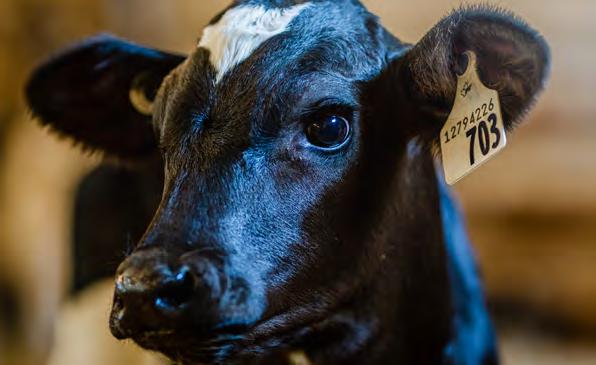
3 minute read
Calf care
from Late Winter 2022
by MilkProducer
CAN A BRUSH BOOST CALF PERFORMANCE?
Research from the University of Florida reveals it can
By Lilian Schaer CONTRIBUTOR
Keeping calves busy during their early lives can lead to healthier, more productive animals. That’s according to research by Dr. Emily Miller-Cushon, an associate professor of animal science at the University of Florida, where she examines calf behaviour to gain insights into how to improve their management and welfare.
Miller-Cushon’s main theory is calves will perform better when they have something to do, such as rub against a brush. Social interaction through group housing and how feed is managed will also impact calf performance, but making sure calves are occupied can also go a long way to boosting performance.
“Calves rest for about 20 hours per day and when they’re awake they want to do something,” Miller-Cushon said in a webinar hosted by Hoard’s Dairyman. “They spend more time grooming than most people would expect, so it’s important to understand this kind of behaviour.”
Grooming includes social grooming—calves grooming each other—as well as self-grooming through licking behaviour or use of calf brushes. Miller-Cushon’s research found calves in a pen with a brush, whether a free-access rotating or stationary brush, spend more time self-grooming and have greater coat cleanliness.
Not all calves respond the same way to brush availability, she noted, since grooming is a behaviour that varies in importance between calves. Overall, calves in her study used a rotating brush for 20 to 30 minutes during a 12-hour observation period.
A manual brush is a more cost-effective option and can be as simple as attaching an inexpensive scrub brush to the side of a pen. Calves still used these brushes, although not as long, spending five to 10 minutes per 12-hour observation period brushing themselves.
“For all calves, their brushing activity
increased around the time of milk delivery or just before,” she explained. “Feeding time tends to be when calves are most active, so that’s also when they are seen using the brush the most.”
Calves with access to a brush spent less time on non-nutritive oral behaviour, such as sucking on pen fixtures (also called pen-directed
sucking). Again, most of this behaviour occurred just before or around milk delivery. According to Miller-Cushon, this suggests the opportunity to do something, such as use a brush, could reduce calf boredom.
Researchers also noted calves with a brush lay more quickly after feeding and were less likely to spend time pen-sucking.
“Overall, (the) calves spent 40 to 60 minutes per 12-hour period on non-nutritive oral behaviour, which again highlights the importance of giving them things to do while they’re up and active—they seem to need a lot of stimulation,” she said.
Giving calves more choice in how to express natural behaviours, such as grooming, will boost their welfare, leading to better performance. It also accommodates individual differences in their behaviours and can give greater insight into how to detect illness by observing behavioural changes.
And finally, early life stimulation improves calves’ ability to learn and adapt to new situations as they go through a lot of changes in their lives.
“We can improve calf welfare performance by giving them more to do, which will impact how a calf copes with management changes throughout its life,” Miller-Cushon concluded.
This project was funded by the Canadian Agricultural Partnership, a five-year federalprovincial-territorial initiative.

800-825-4961
The Dr. Hoof Series II hoof trimming chute works excellent for trimming and wrapping hooves, and can accommodate DA, AI, and PG testing. This chute offers both front and rear leg lifts with the front being a new swing out design that allows for better control and access to the front hooves. It also comes with swing out sides on each side creating a large opening for a large work area to make it much easier to reach those tough to access spots. www.webersfs.com • sales@webersfs.com

DR. HOOF SERIES 2
Lilian Schaer
is a freelance agricultural journalist, writer and communications professional based in Guelph, Ont. She was born in Switzerland and raised on a dairy farm in Grey County. Follow her on Twitter @foodandfarming.
Calf Care Corner delivers the latest information and ideas to help you improve the way calves are raised on your farm. If you have any comments or questions about Calf Care Corner, send an email to info@calfcare.ca. Follow Calf Care Corner on Facebook and Twitter @CalfCareCorner, and sign up for monthly e-blasts at www.calfcare.ca.









